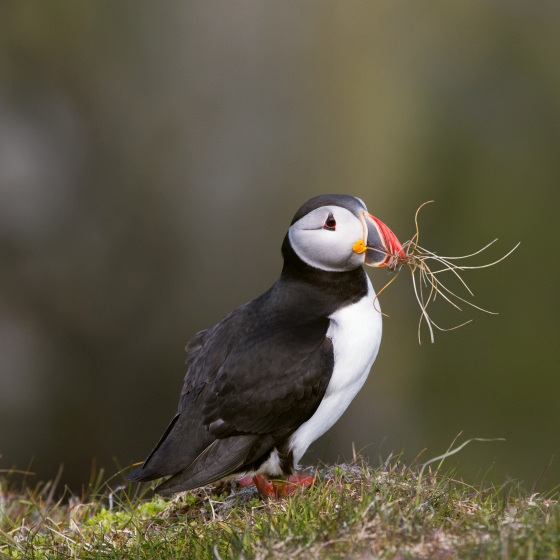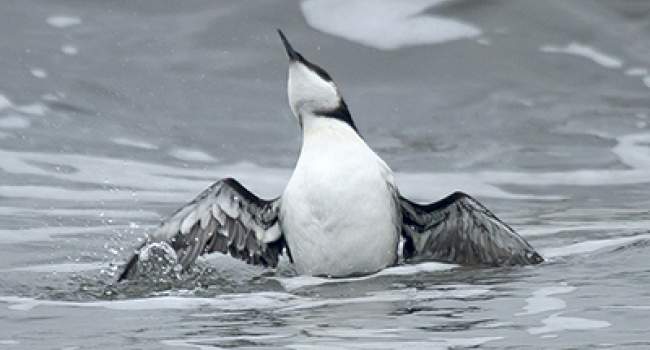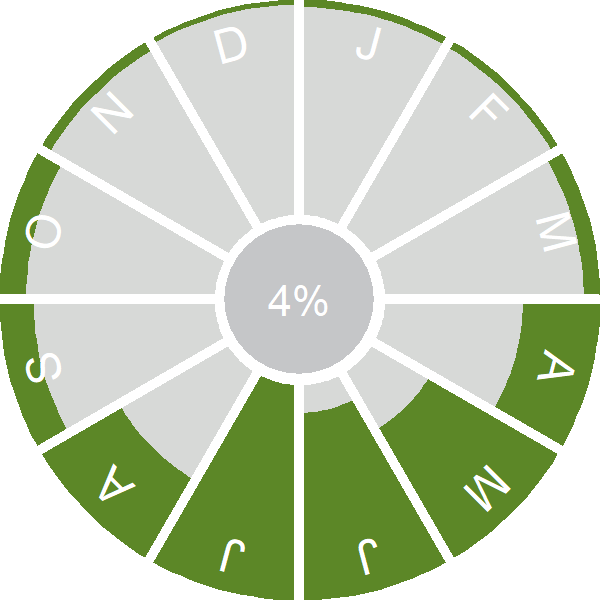Puffin
Fratercula arctica (Linnaeus, 1758)
PU
 PUFFI
PUFFI  6540
6540

Family: Charadriiformes > Alcidae

The most familiar, and some would say charismatic, of our breeding auks, the Puffin is also the most localised in its British breeding range.
Puffins are predominantly burrow-nesters using sites within short grassy swards, often located on sloping ground above cliffs. Although many of these burrows will have been excavated by the Puffins themselves, they are not averse to taking over burrows from Rabbits or Manx Shearwaters.
Our Puffins spend the winter at sea, with ringing data suggesting an extensive wintering range, extending over the eastern Atlantic, south to north-west Africa and with some individuals venturing into the Mediterranean Sea.
Identification
Puffin identification is usually straightforward. The following article may help when identifying Puffin.
Identifying winter Auks

Summer Auks, in breeding plumage, at the shore or near to their colonies are relatively easy to identify. But in autumn and winter we tend to see them flying rapidly past, far offshore, or bobbing around in heavy seas offering poor views. When you add to this that their distinctive breeding plumage and colouring is lost, winter Auks can be a serious challenge to identify and separate.
SONGS AND CALLS
Listen to example recordings of the main vocalisations of Puffin, provided by xeno-canto contributors.
Song
Develop your bird ID skills with our training courses
Our interactive online courses are a great way to develop your bird identification skills, whether you're new to the hobby or a competent birder looking to hone your abilities.
Browse training coursesStatus and Trends
Population size and trends and patterns of distribution based on BTO surveys and atlases with data collected by BTO volunteers.
CONSERVATION STATUS
This species can be found on the following statutory and conservation listings and schedules.
POPULATION CHANGE
The number of Puffins breeding in the UK increased by 37% between 1969–70 and Seabird 2000 (1998–2002). However, a large decline at two of the largest colonies (Farne Islands and the Isle of May) occurred between 2003 and 2008/09. It is unclear, however, whether these declines are representative of the wider UK population; the recent Seabirds Count (2015–2021) should help confirm and quantify the magnitude of any national population decline.
DISTRIBUTION
The bulk of Britain & Ireland's Puffins breed in the Northern Isles, St Kilda, along the North Sea coast south to Yorkshire, in southwest Wales and in western Ireland. In winter they are mostly pelagic and a scattering of records around the coast mainly relate to autumn records and storm-blown individuals.
Occupied 10-km squares in UK
| No. occupied in breeding season | 161 |
| % occupied in breeding season | 5.3 |
| No. occupied in winter | 74 |
| % occupied in winter | 2.5 |
European Distribution Map
DISTRIBUTION CHANGE
Change in occupied 10-km squares in the UK
| % change in range in breeding season (1968–72 to 2008–11) | -26.8% |
| % change in range in winter (1981–84 to 2007–11) | --53.4% |
SEASONALITY
Puffins are mostly recorded during the breeding season from suitable coastal breeding areas, arriving from March onwards. They depart cliffs quickly and are rarely seen during autumn migration or in winter.

Movement
Information about movement and migration based on online bird portals (e.g. BirdTrack), Ringing schemes and tracking studies.
RINGING RECOVERIES
View a summary of recoveries in the Online Ringing Report.
Foreign locations of birds ringed or recovered in Britain & Ireland

Biology
Lifecycle and body size information about Puffin, including statistics on nesting, eggs and lifespan based on BTO ringing and nest recording data.
SURVIVAL & LONGEVITY
View number ringed each year in the Online Ringing Report
Maximum Age from Ringing 
|
42 years 0 months 21 days (set in 2019) 
|
Typical Lifespan 
|
18 years with breeding typically at 5 year |
Adult Survival 
|
0.924±0.006 ( Female: 0.924±)  
|
BIOMETRICS
Wing Length 
|
Adults | 159.5±4.5 | Range 152–167mm, N=583 |
| Juveniles | 138.7±6.6 | Range 131-145mm, N=2392 |
Body Weight 
|
Adults | 387±40.1 | Range 325–450g, N=467 |
| Juveniles | 264±26.9 | Range 220–305g, N=4512 |
Feather measurements and photos on featherbase 
CODES & CLASSIFICATION
Ring size 
|
E |
Field Codes 
|
2-letter: PU | 5-letter code: PUFFI | Euring: 6540 |
For information in another language (where available) click on a linked name
Research
Interpretation and scientific publications about Puffin from BTO scientists.
CAUSES AND SOLUTIONS
Causes of change
The reasons for the population increases between 1969–70 and Seabird 2000 are not known (JNCC 2022). Productivity was low between 1998 and 2013 and this may have contributed to declines, with food shortages and high levels of rainfall causing flooding of burrows both being implicated (JNCC 2022). An Icelandic study found a strong correlation between Puffin breeding productivity and local sea surface temperatures (which can affect prey abundance) (Hansen et al. 2021), and it is likely that UK colonies are also being affected by changes to sea surface temperatures caused by climate change. Prey shortages result in longer foraging ranges and lower productivity which ultimately leads to declines (Fayet et al. 2021). The population may also be affected by survival and it is believed that a 'wreck' in the winter of 2013/14 following several severe storms may have had a substantial effect on the Puffin populations at some UK sites (JNCC 2022).
PUBLICATIONS (2)
An experimental study of reduced parental effort and future reproductive success in the puffin, Fratercula arctica
Factors influencing the survival of Puffins Fratercula arctica at a North Sea colony over a 20-year period
Links to more studies from ConservationEvidence.com
Would you like to search for another species?












Share this page